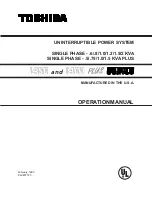
15
5.1.5.5. Vertical tower-type mounting with backup extension (battery
module).
t
The description in this section refers to a device with a
single battery module. For a greater number, proceed in a
similar way.
t
Take the 4 plastic pieces in the form of an angle supplied
with the UPS and the two extensions supplied with the bat-
tery module, and install them to obtain two bases to hold
the device and the battery module.
t
Place the UPS and battery module upright between the two
bases (see Fig. 8) and at a distance of 70 mm from each
end, as shown in Fig. 6.
t
Rotate the control panel according to section 5.1.5.4.
Fig. 8.
Vertically mounted tower-type model with backup exten-
sion (battery module).
5.1.5.6. Preliminary considerations before connection.
t
Check that the information on the device’s nameplate is
that required for installation.
t
All devices in the range feature a cord with plug for the input
and IEC connectors for the output, as connecting elements
for power. Other connections are made through connectors,
including connection of the device to the battery module.
t
Thermal control of these devices is carried out with the
passage of forced air from the front to the rear.
The front surface and about 15 cm on the rear side should
be left free of obstructions to facilitate the free circulation
of air for ventilation.
t
Protection board:
It will have a type-B differential circuit breaker and a short
circuit protection (C-curve circuit breaker) for the UPS’s
input line.
As for size, they will be at least the current indicated on the
nameplate of the UPS.
t
Only the rated current as indicated by the EN-IEC 62040-1
safety standard is printed on the nameplate of the device.
For the calculation of the input current, the power factor and
the equipment's own performance have been considered.
Overload conditions are considered a non-permanent and
exceptional working mode.
t
The cross section of the input line cables is determined
by the current indicated on the nameplate of each device,
in compliance with local and/or national Low-Voltage
Electrotechnical Regulations.
t
If peripheral input and/or output elements, such as
transformers or autotransformers, are added to the UPS,
the currents indicated on the nameplates of these elements
must be taken into consideration when determining
appropriate cross sections, in compliance with local and/or
national Low Voltage Electrotechnical Regulations.
t
When a device incorporates a galvanic isolation
transformer as an optional extra or installed
independently, either at the input, output or both, it must be
fitted with protection against indirect contact (differential
circuit breaker) at the output of each transformer, since, due
to its own insulation properties, it will prevent the tripping
of the protections placed on the primary of the isolation
transformer in case of electric shock on the secondary
(output of the isolation transformer).
t
We remind you that all the isolation transformers installed
or factory supplied, have the output neutral grounded
through a bridge between the neutral terminal and ground.
If the isolated output neutral is required, this bridge must be
removed, taking the precautions indicated in the respective
local and/or national low voltage regulations.
t
This device is suitable for installation in networks
with TT, TN-S, TN-C or IT power distribution
systems, taking into account at the time of installation the
particularities of the system used and the national electrical
regulations of the destination country.
t
All of the models in this series have an input polarity
detector (phase-neutral), which activates a
modulated audible alarm every 2 seconds and displays the
message on the ‘
SF
’ display in the event of a fault.
When the circumstance arises, disconnect the plug from
the mains socket and rotate it 180º.
If the same alarm condition is maintained, it will be a two-
phase power line signal or installation without neutral
referenced to earth. Contact our
T.S.S.
or the distributor
before connecting loads to the output.
t
The ADVANCE RT2 features terminals for the installation
of an external emergency power off button (EPO) or, failing
that, a single device must be installed to cut the power
supply to the loads in any operating mode.
5.1.5.7. Preliminary considerations before connection, regarding the
batteries and their protections.
t
SPS.ADVANCE RT2 devices incorporate the batteries in the
same box as the device, except for B0 and B1 models.
The UPS’s battery protection is internal by means of fuses
and is therefore not accessible to the user.
The battery modules have a circuit breaker accessible to
the user and a second internal protection consisting of a
non-accessible fuse.
t
IMPORTANT FOR SAFETY: If batteries are installed
independently, the accumulator group must be fitted
with a bipolar circuit breaker or disconnect fuse of the size
indicated in Tab. 2.
SPS.ADVANCE RT2
UNINTERRUPTIBLE POWER SUPPLY (UPS)
USER'S MANUAL
YOUR CONNECTION TO SAFETY
Thiele KG
• V
orderer W
einberg 26 • D-71522 Backnang • T
el.: +49 (0)7191 3560-0
• Fax.: +49 (0)7191 3560-19
• info@thiele-kg.de
• www
.thiele-kg.de
Thiele KG
• V
orderer W
einberg 26 • D-71522 Backnang • T
el.: +49 (0)7191 3560-0
• Fax.: +49 (0)7191 3560-19
• info@thiele-kg.de
• www
.thiele-kg.de
YOUR CONNECTION TO SAFETY
klick to
www
u-s-v
YOUR CONNECTION TO SAFETY
klick to
www
ACDC-DCDC
YOUR CONNECTION TO SAFETY
klick to
www
SYSTEME
YOUR CONNECTION TO SAFETY
klick to
www
CONTACT
YOUR CONNECTION TO SAFETY
klick to
www
CALLBACK
















































